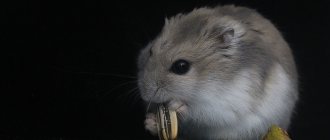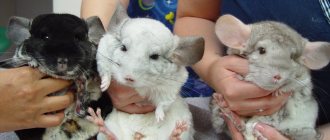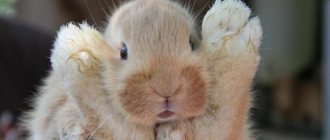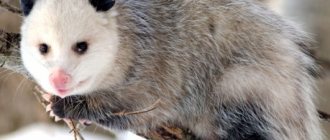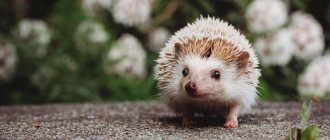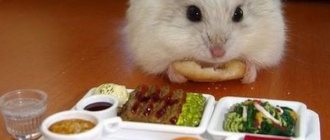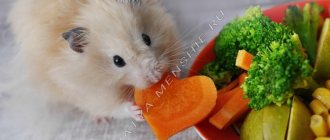There are a wide variety of ferret foods on the market, but don’t forget that most of them are economy-class foods that may not meet your pet’s nutritional needs. Sometimes such foods can harm the ferret and its digestive system.
Ferrets eat almost like kittens
The nutritional needs of a ferret are in many ways similar to those of a kitten, so some cat foods are suitable for ferrets. When purchasing food, you must check the integrity of the packaging, shelf life and manufacturer. Food storage conditions must be carefully observed.
Feeds for ferrets are divided into:
- specialized food for ferrets;
- premium cat and kitten food suitable for ferrets;
- food for cats and kittens, which is suitable for feeding super-premium ferrets.
Any animal has its own nutritional needs, so food must be selected based on the individual characteristics of your pet.
Choosing food for your ferret
A good ferret food or premium food should meet the following requirements:
- high content of animal fat;
- high content of animal protein;
- low plant fiber content.
When choosing dry food to feed your ferret, you need to pay attention not only to the percentage of protein, fat and carbohydrates, but also to the ingredients that come first. The ferret's body better absorbs and digests components of animal origin, so make sure that the food contains animal proteins and fats. Products of plant origin will not be absorbed by the ferret's body, or the digestion process will occur too slowly.
At the beginning of the composition there should be meat components, and not waste meat products (bones, skins, entrails and others). Dry food should contain from 30 to 50% of the protein part (protein mainly of animal origin), from 18 to 25% of the fat part. No more than 2% fiber is allowed, as it negatively affects the health of your pet’s digestive system.
Examples of premium ferret foods:
- FERRETastic – the manufacturer of this food is Germany. The composition includes high-quality turkey, chicken and salmon meat. The meat part content is 87%, the protein part content is 40%, of which 94% is animal protein. The food is recommended for healthy ferrets of any age category.
- CHICK norRIS – this food is also produced in Germany. This is a one-ingredient dry food with a low carbohydrate content. Contains pure chicken meat. The meat part content is 87%, the protein part content is 50%, of which 98% animal protein, 8% carbohydrates. The food is intended for ferrets of any age category and is optimized for predators. Does not contain grains or gluten. It is hypoallergenic and easily absorbed by the animal's body.
- Revolution – the manufacturer of this food is Germany. It is a dry complete food with a high protein content and low carbohydrate content. It does not contain grains or preservatives, is hypoallergenic and belongs to the super-premium class. This food contains turkey, chicken, duck, white fish and rabbit. The content of the meat part is 86%, the protein part is 48%, of which 96% is animal protein. The food is recommended for healthy ferrets of any age.
- Orijen Cat and kitten is a dry food that best suits the nutritional needs of a ferret. Contains phytocomponents that improve the animal's metabolism and remove toxins from its body. In addition, the food contains antioxidants and mixed tocopherols. The food contains chicken and turkey. Meat content 80%, protein 42%, carbohydrates 17%. The product is suitable for feeding ferrets of any age.
- Bosch Totally Ferret BABY is a dry food that is perfect for feeding ferrets, meeting their nutritional needs. The product contains poultry. Does not contain corn grains or soy products, GMOs or dyes. The content of the protein part is 42%, the fat part is 24% and 14.5% carbohydrates. The food contains taurine and omega oils, which are beneficial for the health of ferrets. The food is specially designed for feeding ferrets of any age.
- Golden Eagle Holistic Adult Cat - food that best meets the nutritional needs of a ferret. It contains chicken meat, omega fats that are beneficial to the health of the animal, enzymes necessary for the normal functioning of the digestive system and lacto-bifido bacteria. Does not contain GMOs, preservatives or dyes. The food contains 43% protein, 19% fat and 18.1% carbohydrates. Promotes normal digestion and intestinal function of the ferret. Suitable for feeding animals of any age.
It is better to store dry food in a separate container.
Farshekashi recipes
Farshekasha is a mixture that is often used to feed ferrets. It may contain several ingredients.
Recipe No. 1
Designed for young puppies and growing individuals. The composition of farshekashi includes:
- chicken stomachs – 1 kg;
- chicken necks – 2 kg;
- rice or buckwheat groats – 400 g.
The breeder presented the recipe for farshekashi in his video below:
Preparing farshekash is very simple:
- Grind the cereal into flour, then cook until completely cooked.
- Grind the offal into minced meat, which is mixed with the finished porridge.
- Add vitamins in the required quantities to the minced meat.
Recipe No. 2
This recipe is prepared for adult animals. Farshekasha consists of the following components:
- cottage cheese – 60 g;
- fish – 150 g;
- beef heart – 100 g;
- chicken meat – 0.5 kg;
- rice – 100 g;
- poultry fat – 10 g.
The cooking process is very simple:
- Cook the rice for 2-3 hours, grind the remaining ingredients into minced meat.
- Mix the resulting minced meat with porridge, add the necessary vitamins.
- Divide the finished minced meat into portions and place in the freezer.
Dry food storage
Before opening the package, the food can be stored in any dry place, avoiding direct sunlight.
After opening the package, the food must be poured into a separate container with a tight-fitting lid. The container can be made of metal or plastic materials.
Dry food should be stored in a dry container, away from humidity and direct sunlight.
IMPORTANT! Do not mix leftover old food with new food.
Before using the dry food storage container, it must be thoroughly rinsed and dried. The food must be stored in accordance with the storage rules indicated on the packaging.
These simple tips will help you provide your pet with delicious and fresh food every day.
Do you store food in a separate jar?
Sometimes ferrets don't like changing food.
Water in the diet
Ferrets often drink liquids, especially if they are fed dry snacks. With this diet, the number of approaches to the drinking bowl reaches 7-12 times. It is important to keep water bowls clean, and the water itself should be fresh, at room temperature. Filtered water is best for drinking and is changed at least 2 times a day.
Ferrets should always have water, because it not only promotes thermoregulation, but also saves the animal from sunstroke in the summer.
What to do if your pet doesn’t want to eat a new type of food?
Frequently changing food for ferrets is not recommended, so you need to choose a brand of food that is sold in your city and that you can afford at any time.
It is impossible to determine whether the food is suitable for your pet at first glance. It is necessary to give the ferret’s body time to get used to the new type of product, and only then draw conclusions about its suitability.
If your pet refuses to accept food from any manufacturer, then a special analysis can be performed that allows you to determine how your ferret's body reacts to this food.
If the ferret does not want to eat a new type of food even after a long period of time, then it is best to abandon this manufacturer and choose the food that is most suitable for your pet. With the correct selection of food:
- The ferret's fur is bright, shiny, without foreign odors or secretions;
- the smell from the toilet is minimal or practically absent;
- the stool has a uniform consistency, without mucus and other secretions, and so on.
Features of feeding in different periods
The diet of ferrets becomes special at certain periods of life. What remains common is the obligatory presence of minerals and vitamins.
Growth period
During breastfeeding, young ferrets receive the nutrients their bodies need through their mother's milk. Deprived of mother's milk, ferrets' gastrointestinal tract becomes vulnerable to infections, which is why probiotics should be kept in the breeder's medicine cabinet at all times.
Ferrets are transferred to “adult” feeding 3-4 weeks after birth. At this time, their baby teeth begin to erupt. In order for babies to quickly get used to this diet, liquid minced meat is introduced into the diet, and low-fat cream or baby kefir is added to the mother’s menu.
Don’t forget about vitamins - 3-4 drops of fish oil are dripped onto the tongue of ferrets. If more male furos were born in the litter, more calcium and phosphorus are added to the food, since males are more active.
Don't forget to give your pets vitamin pastes and supplements. Lack of nutrients negatively affects the growth and further development of ferrets.
Shedding period
Furo molt in early spring and autumn, with the exception of pregnant females who shed on the 20th day of pregnancy, and animals that have suffered a hormonal imbalance. Shedding lasts 1-2 weeks and is accompanied by severe itching. In some areas of the body there is practically no hair.
Ferrets are very clean, so they carefully lick themselves, as a result of which a lot of hair gets into the gastrointestinal tract and vomiting begins. To prevent this from happening, the animals are given fur-removing pastes. Pets are helped to cope with shedding by combing their fur with a brush or using a furminator.
During molting, ferrets need vitamin complexes containing sulfur, brewer's yeast and B vitamins. Thanks to which the new fur will be thick and shiny.
Pregnancy period
In order for the offspring to be born healthy, a pregnant female is given an individual diet.
The menu of a pregnant female must contain:
- phosphorus, calcium for strong teeth and bones;
- vitamins A, E, D and group B - in increased quantities.
When feeding chorihi with natural food, the menu includes meat and bone meal, calcined cottage cheese, and fish oil. If the female eats dry snacks, she is given special food for pregnant women or a product intended for cats. You can’t overfeed a choriha – this leads to obesity, but limiting the female’s nutrition is also dangerous.
Before childbirth and in the first days after it, the chorikha's appetite worsens. The ferret's menu during lactation is identical to the diet during pregnancy. Nutrient requirements are still high.
Origin of the species and description
Photo: Ferret
The ferret is a predatory mammal from the mustelidae family. Its closest relatives are the ermine, mink and weasel; they are very similar in appearance. Man has domesticated these brave predators for quite some time. For centuries, ferrets have gotten along well in human homes, becoming adored pets for many.
As proof of this, we can cite the example of the famous painting by Leonardo da Vinci, which is called “Lady with an Ermine”; in fact, it depicts an albino ferret in the hands of a woman. This ferret was bred in ancient times, more than two thousand years ago in the south of Europe, it is called furo. Previously, such pets were kept like cats, and they hunted rabbits with them.
Video: Ferret
There are several varieties of ferrets, which differ slightly from each other in their characteristic features, which we will try to understand in more detail. There are 4 species of these animals in total. Three of them (steppe, blackfoot and black) live in the wild, and one (frett) is completely domesticated.
Let us characterize the distinctive features of each variety:
- The black-footed ferret (American) is much smaller in size than the steppe ferret, weighing just over one kilogram. The general tone of its fur is light brown with yellowish tint, and the back, tip of the tail and paws are much darker, the color reaches almost black. The ears are large and rounded, and the limbs are powerful and squat;
- The steppe ferret (white) is considered the largest among its fellow tribesmen. Males weigh about two kilograms, females are twice as small. The body of the steppe ferret reaches half a meter in length, sometimes a little more. His fur is long, but not particularly thick, so his dense and warm undercoat shows through. The animal's coat is light in color, only the paws and the very tip of the tail may be darker;
- The forest ferret (black) in weight and size is something between the first two species. Its weight reaches 1.5 kg. Usually this predator is black-brown in color, although there are also reddish and completely white specimens (albinos);
- Fret is a decorative variety created by people. This ferret is slightly smaller in size than the white one, and the color scheme of the fur coat is very diverse. The fur is very pleasant, fluffy and thick.
With all the listed distinctive external features, ferrets of various species have many common characteristics that characterize these interesting and agile representatives of the mustelid family.
WHAT CAN YOU FEED?
Ferrets are carnivores in nature and their diet is based on protein. Fiber, which is found in vegetables and fruits, is practically not absorbed by the ferrets’ body; therefore, based on this, we can make a list of foods that are allowed and beneficial for a ferret:
- poultry meat (80% of the diet);
- rabbit meat;
- lean beef;
- lean fish (15% of the diet);
- boiled quail or chicken eggs (5% of the diet);
- porridge (buckwheat, rice, pearl barley: 15-25% of the diet);
- vegetables and fruits (cucumbers, tomatoes, zucchini, pumpkin, apples, bananas, pears: 1-2% of the diet);
- low-fat dairy products (5-10% of the diet);
- dried fruits (very rarely);
- “farshekasha” (a mixture of minced meat and cereals).
How hamsters live in a cage, care and maintenance at home. Tips for choosing a hamster.
From here you will find out how long a red-eared turtle can live without water, and whether you should worry if it hides.
What to do if the red-eared turtle does not open its eyes, is it dangerous?
You can also feed your ferret with a special combined dry food, which is sold in pet stores in the form of an already formed mixture. If this particular option for feeding the animal was chosen, then it is necessary to choose the “correct composition”. Good dry food consists of processed poultry by-products (liver, heart, kidneys), its fat, eggs, cereals (barley, rice), meal (bone meal), and various vitamins. The proportion of fiber and plant fibers in the feed should not exceed 2-3%.
HOW IS IT CORRECT?
A ferret is not a cat or a dog, so you should not leave its bowl on the floor in an open room. Firstly, the animal has the habit of taking food out of the bowl, and secondly, it can hide pieces of remaining food.
It is best if the food bowl is securely attached to the walls of the cage so that it cannot be torn off or knocked over. To ensure that the ferret’s home is associated with a safe and cozy place, it is better to feed it in an enclosed space.
The most common diseases of red-eared turtles: symptoms and treatment with various drugs.
What does a domestic hamster like to eat, what kind of diet should he have - https://tvoipitomec.com/gryizunyi/chem-kormit-homyaka-v-domashnih-usloviyah.html
Depending on the age of the animal, the food is either crushed or cut into cubes. If you plan to introduce “farshekashi” into your diet, it usually has a fairly thick consistency: cooked meat and cereal are mixed and twisted using a blender or meat grinder. In other cases, avoid grinding the food too much to prevent your ferret's teeth and gums from weakening.
Sometimes, in order for the ferret to “sharpen his teeth”, you can give him chicken heads, necks or paws. The little predator can easily cope with small and large bones, and such “charging” for the teeth will only benefit him.
Video: feeding the pet
https://youtube.com/watch?v=Omfir5lNYos
Feed yourself
There is another, alternative way of feeding a ferret, close to its natural conditions.
Of course, in domesticated ferrets the instinct to hunt is present, but it manifests itself more in a playful form. However, feeding with live birds, food cockroaches, mice, and mealworms can be considered as entertainment or game, followed by a “snack.”
There are debates about the ethics of such feeding, because not every breeder will like to see their pet’s face covered in blood, and “it’s a pity for the bird.” But such food is most consistent with what a ferret gets for itself in the wild. It contains vitamins and all the elements that help maintain good animal health for many years.
However, in urban conditions feeding a pet in this way is quite problematic.
The issue of ferret nutrition must be taken very seriously.
It is important to avoid foods containing nitrates, GMOs and all kinds of preservatives. Since harmful substances tend to accumulate in the outer shells of vegetables, fruits and the skin of poultry, it is better not to offer them to your pet.
